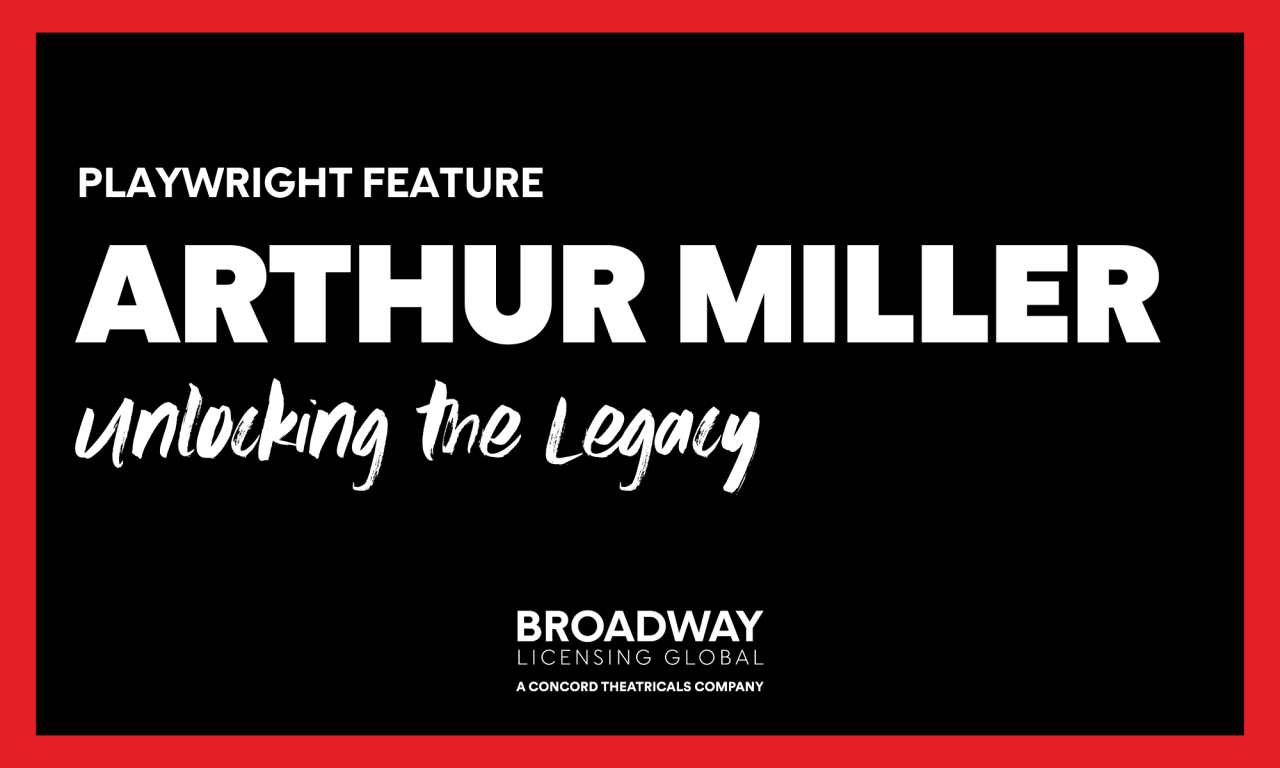Step into the world of Arthur Miller, one of America’s most revered playwrights. Explore a collection of his timeless works, from the poignant struggles of Death of a Salesman to the gripping moral dilemmas of The Crucible. Miller’s keen insight into the human condition and unwavering social conscience shine through in each play, offering enduring themes, rich characterizations, and profound social commentary that define his legacy.
Join us as we delve into these essential plays, resonating on our stages, our schools, and our culture!
Death of a Salesman
Winner of the 1949 Tony Award® for Best Play and the 1949 Pulitzer Prize for Drama
The story revolves around the last days of Willy Loman, a failing salesman, who cannot understand how he failed to win success and happiness. Through a series of tragic soul-searching revelations of the life he has lived with his wife, his sons, and his business associates, we discover how his quest for the “American Dream” kept him blind to the people who truly loved him. A thrilling work of deep and revealing beauty that remains one of the most profound classic dramas of the American theatre.
After the Fall
As Howard Taubman outlines the play: “At the outset Quentin emerges, moves forward and seats himself on the edge of the stage and begins to talk, like a man confiding in a friend. In the background are key figures in his life, and they move in and out of his narrative. The narration shades into scenes, little and big. They are revelations and illuminations. They remind Quentin of an awkward young girl whom he made proud of herself. They bring the tortured image of his mother’s death and another of his mother’s fury with his father, who lost all in trying to save a floundering business. They crisscross through his relations with a number of women—the first wife who wanted to be a separate person, the second who drove him into a separateness and a possible third who knew, as a German raised in a furnace of concentration camps, that ‘survival can be hard to bear.’ These intertwining images bring back the memories of inquisition when men were asked to name names of those who had joined with them in a communism that they mistook for a better future…After the Fall is a pain-wracked drama; it is also Mr. Miller’s maturest…For to sit in Mr. Miller’s theater is to be in an adult world concerned with a search that cuts to the bone.”
All My Sons
Winner of the 1947 Tony Award® for Best Play
During the war Joe Keller and Steve Deever ran a machine shop which made airplane parts. Deever was sent to prison because the firm turned out defective parts, causing the deaths of many men. Keller went free and made a lot of money. The twin shadows of this catastrophe and the fact that the young Keller son was reported missing during the war dominate the action. The love affair of Chris Keller and Ann Deever, the bitterness of George Deever returned from the war to find his father in prison and his father’s partner free, are all set in a structure of almost unbearable power. The climax showing the reaction of a son to his guilty father is fitting conclusion to a play electrifying in its intensity.
The American Clock
Subtitled “a mural for the theatre,” the play employs a series of vignettes and short scenes, with the actors portraying some fifty-two characters, to capture the sense and substance of America in the throes of the Great Depression. The central figures are the Baums, a wealthy family whose fortune has vanished in the stock market crash, but their story is amplified and illuminated by brief glimpses of other lives; a farmer who has lost all in the dust bowl; a prostitute who exchanges her favors for dental work; a white Southern sheriff in thrall to a black short-order cook; a young man who dreams of success on Tin Pan Alley, etc. Moving deftly from scene to scene, some funny, some movingly poignant, the play becomes a deeply affecting evocation both of a tortured time in American history and of the indomitable spirit of the people who survived and prevailed in the face of unaccustomed adversity.
A View from the Bridge
As told by the New York Daily News, “… is a tragedy in the classic form and I think it is a modern classic…the central character is a long-shoreman who, though his mind is limited and he cannot find words for his thoughts, is an admirable man…When two of his wife’s Italian cousins—submarines they are, in the waterfront argot—are smuggled into this country, he makes room for them in his home. Gratefully they move in among his wife, his children and the teen-age niece whom he has brought up and whom he has come to love, he thinks, as a daughter. And now the stage is set for tragedy. One of the illegal immigrants has a family in Italy for whom he is working; the other young, extraordinarily handsome, and exceedingly blonde, is single. He wants to become an American, and he falls in love with his benefactor’s niece. If he marries the girl he will no longer have to hide from immigration officials. A monstrous change creeps up on the kind and loving uncle. He is violently opposed to this romance and is not intelligent enough to realize that this opposition is not motivated, as he thinks, by a dislike of the boy and a suspicion that he is too pretty to be a man, but by his own too intense love for his niece. Not even the wise and kindly neighborhood lawyer can persuade him to let the girl go. This is an intensely absorbing drama, sure of itself every step of the way. It makes no false moves, wastes no time and has the beauty that comes from directness and simplicity.”
The Price
As outlined in Variety: “…the conflict, the basic jealousy and the lifetime of, if not hatred, at least corrosive, though unacknowledged anger, is between two brothers, as well as resentment against a selfish, child-devouring father. The siblings meet, after a sixteen-year estrangement, in the attic of the family residence, where the old furniture is to be disposed of. The first is a policeman who sacrificed his education and probably a career as a scientist to care for his ruined, invalid father. The other, who arrives late, is an eminent surgeon who walked out on the demands of family to concentrate on medicine and personal success. Miller works up to the showdown scene slowly. The policeman and his wife first talk of the past and present to fill in some of the background. Then there is a very long, richly amusing, curiously revealing and enjoyable scene between the officer and a marvelously crotchety, humorous and wise old Jewish dealer who has come to buy the furniture but refuses to set a price without prolonged philosophic conversation. When the surgeon arrives, the brothers take a little time for amenities and feeling each other out before the basis of their long alienation and mutual bitterness emerges into short, blunt, enraged accusations. It is a taut, exciting and superbly theatrical scene, and it reveals the characters, including strengths and weaknesses, of the brothers to each other and themselves—as well as to the audience.”
The Last Yankee (Full Length and One Act)
Two men, one in his late-forties, the other twenty years older, meet in the waiting room of a New England state mental health facility only to discover that they have done business together in the past. Inside the facility, each of their wives recovers from a nervous breakdown. Leroy Hamilton, a descendent of founding father, Alexander Hamilton, has spent his life as a highly skilled carpenter. His wife, Patricia, the daughter of Swedish immigrants and herself the mother of seven children, cannot reconcile what she considers to be Hamilton’s deliberate under-achievement with her own family’s grasping attempts at assimilation and affluence. Purposefully foregoing her anti-depression medication for a number of weeks, Patricia has begun to display a new clarity of thought that promises to shatter irrevocably the status quo of her life with Hamilton. The older, more affluent couple, share an equally tense marriage despite their prosperity. Karen Frick, though, has gone farther down the path of no-recovery than even the more frequently hospitalized Patricia. As roommates, Karen and Patricia have been sharing stories about their husbands—and the final meeting between them all, demonstrates the price and rewards of even strained marriages.
The Man Who Had All the Luck
The play chronicles the rise of David Beeves from an auto mechanic to a successful mink rancher. However, while David’s fortunes mount, the lives of those around him are in a constant decline. David desperately searches for some meaning to his good fortune and begins to wish that some great disaster would be visited upon him and break his chain of good luck. Mr. Miller views The Man Who Had All the Luck as a reverse of the story of Job. He says of the play, “the story of a man who cannot come to terms with the total destruction of his property and all his hopes, when he has done nothing to earn such treatment from God or fate, is very much the same as that of a man who can’t seem to make a mistake and whose every move turns out to be profitable and good…The simple fact is that, as moving and imperative as our fates may be, there is no possibility of answering the main question—why am I as I am and my life as it is? The more answers one supplies the more new questions arise.” In the end, David starts to come to terms with his good fortune and to feel that his luck may be of his own making and not an accident of fate.
An Enemy of the People
Adapted from Henrik Ibsen’s play
A small Norwegian town has just begun to win fame and wealth through its medicinal spring waters. Dr. Stockmann, resident physician in charge, discovers that the waters are poisoned. On receiving proof of this, he immediately reports to his associates, but is shocked to find that instead of being thanked, he is looked upon as a dangerous crank, motivated by a desire to prove that his fellow townsmen are wrong, and to bring ruin upon them. As the people who run the local paper do their utmost to urge secrecy and compromise, the determined doctor realizes that the honesty and idealism he has counted upon to make the truth prevail, simply does not exist in the face of selfish “practical” interests. The press will not report his findings; the officials refuse to give him a hearing; he loses his position and the townspeople boycott him; and every weapon of blackmail, slander, and eviction are brought against his family. At the end, the townspeople, gathered around the doctor’s home, throw stones through the windows. Stockmann addresses his family: “But remember now, everybody, you are fighting for the truth and that is why you’re alone. And that makes you strong.”
The Crucible
Winner of the 1953 Tony Award® for Best Play
Widely considered a masterpiece, this timeless classic challenges American ideas of power, intolerance, and justice. In the Puritan community of Salem, Massachusetts, a servant girl accuses a farmer’s wife of witchcraft. One accusation spirals into many, uncovering a web of bigotry and deceit that changes their lives forever. Among the most produced plays since its 1953 debut, The Crucible is both a gripping historical drama and an evergreen parable of contemporary society.
No Villain
Over six days during the spring break of 1936 at the University of Michigan, a twenty-year-old college sophomore wrote his first play, NO VILLAIN. His aim was to win the prestigious Avery Hopwood award and, more importantly, the $250 prize he needed in order to return to college the following year. Miller won the award, but the play would remain buried until it received its world premiere nearly eighty years after it was written. No Villain tells the story of a garment industry strike that sets a son against his factory proprietor father. Here, Miller explores the Marxist theory that would see him hauled before the House Un-American Activities Committee years later. This remarkable debut play gives us a tantalising glimpse of Miller’s early life, the seeding of his political values, and the beginning of his extraordinary career.
A Memory of Two Mondays
Writing of A Memory of Two Mondays, John Chapman called it: “a one-act fragment about people who work in an automobile parts warehouse in the early Roosevelt days. Properly speaking, it has no plot—yet something does happen to almost everybody. A youth gets a chance to go to college. A drunk reforms. Another drunk rebels. A young man with a song in his soul finds himself forgetting the song as poverty and a lack of opportunity grind him down.”
Somewhat Chekhovian in style, A Memory of Two Mondays provides an unusual number of meaty parts for actors.
Incident at Vichy
1942. The detention room of a police station in the occupied Vichy Zone. Eight men have been picked up for questioning, for the reason everyone knows but can’t begin to consider. As details of the consequences of the occupation, and of the Nazis’ Racial Program, begin to emerge, each man must consider for himself how he responds. In one of the clearest and most urgently moral plays by the greatest American moral dramatist, Incident at Vichy is a tense, incisive examination of the choices each of us can make—and how we assuage our consciences—when our own society asserts domination over those considered “other.”
The Archbishop’s Ceiling
The setting is an ornate room in a former Archbishop’s palace in an Eastern European capital, a room which has probably been bugged by the secret police. The central character is a middle-aged author, Sigmund, who, having embarrassed the current regime, is faced with the choice of detention and punishment or defection to the West. He is encouraged in the latter by two of his former friends, also writers, his compatriot Marcus, an ex-political prisoner now in favor with the regime, and Adrian, a visiting American with strongly liberal ideals. The situation is complicated by the presence of Myra, a poet and actress, who has been the mistress of all three. It is the complexity of the relationship of these four, the inextricable interweaving of politics, art and sex, and the constant uncertainty as to whether what they say may be overheard that makes for a rich and deeply intriguing play—and one that, in the final essence, raises questions not only about morality and individual responsibility but also about the very nature of reality in a world where absolutes seem to shift and blur as expediency dictates.
The Creation of the World and Other Business
Dividing his play into “three questions on the human dilemma,” the author begins with a charming and gently humorous retelling of Adam and Eve (and God) in the Garden of Eden. After their expulsion from paradise, Eve gives birth to Cain, watched over by a scheming Lucifer—who seeks to share the power of a God now angered by the errant ways of his creations. In the concluding portion of the play, with mounting dramatic intensity, Cain kills his brother, Abel, and is sent out as a wanderer, as the final dilemma is explored: “When every man wants justice, why does he go on creating injustice?” Throughout the action, which alternates scenes of sprightly humor with absorbing confrontations between God and Lucifer and God and his fallible creations, the striking pertinence of the play becomes ever more clear. It is a parable for our time, and all time, rich with philosophic insights and alive with vivid theatricality.
Elegy for a Lady
A Man enters a small boutique, hoping to find a suitable gift for his young mistress, who is facing a grave operation. Unaccountably he quickly finds himself confiding in the Proprietress, speaking without hesitation of the pain he feels at having his telephone calls to his loved one unreturned, of his fear that her condition may be fatal. The Proprietress consoles him, suggesting that perhaps she wants to spare him, that she needs to face her ordeal alone and without added burden that his involvement would impose. As they speak specters of other deep-seated concerns arise: the difference in age between the Man and his mistress; his unfulfilling marriage; the emptiness of material success without love to enrich it; the void that might have been filled had there been the possibility of children; the frustration of being unable to make a true and total commitment to another person. It is almost as though the Proprietress might be—or has become—the absent mistress. As the play ends the Man and the Proprietress embrace, two strangers grateful for the small miracle which, if only for a brief moment, has let them share closeness always hoped for but seldom achieved.
The Golden Years
Set in 1522, The Golden Years revolves around Cortez’s invasion of Mexico during Montezuma’s reign. Written during the early stages of World War II, the conflict between the Spanish general and the Aztec king mirrors the relationship between Hitler and the leaders of the European states and America. Arthur Miller says of his play, “The Golden Years…[is a] look at passivity and its risks, but here the society as well as an individual is at stake. Montezuma, like the democracies facing Hitler, was as though hypnotized. Weakened by self-doubt he looks to Cortez, manifestly a brute and conqueror, as one who may nonetheless bear within him the seed of the future.” Montezuma looks for meaning in Cortez, where there is only greed for gold, lust for power and desire to conquer. While Montezuma attempts to use reason and words, Cortez uses force and crushes the flourishing culture of the Aztecs.
Some Kind of Love Story
Angela, a hard-bitten call-girl, is visited by Tom, a private detective of long acquaintance, who is convinced that she can supply information about a murder case which, some years earlier, resulted in a miscarriage of justice. As Tom plays on their former closeness, trying to draw out the facts he seeks, Angela withdraws behind a schizophrenic screen of multiple personalities ranging from a brazen creature named Leontyne, to a shrinking violet called Emily, to a haughty English-woman named Renata. Doggedly persistent, Tom does, in the end, break through the fears which have driven Angela to hide the truth within herself. With chilling intensity she pours through a tale of duplicity and corruption and recounts how an innocent man ended up paying for the crimes of others. As the play ends Tom offers to drive Angela to her next assignation—relieved that his quest has ended but, at the same time, disturbed by the knowledge that his worst fears have been borne out.
Danger: Memory!
The first play, I Can’t Remember Anything, is a gentle, poignant study of two old friends, an elderly man and woman, who live in nearby houses and often take their meals together. She is a wealthy widow whose life seems to have come to a stop after her husband’s death; he is a retired draftsman, a doctrinaire Communist who was her husband’s best friend despite the radical differences in life styles and political outlook. Both lament the passing of better days, the lack of contact with loved ones, and the loss of memory that clouds the meaningfulness of the time left to them. (1 man, 1 woman.)
The second play, Clara, is a powerful and moving drama in which an aging father is forced to come to grips with the crushing reality of his daughter’s senseless murder. Grilled relentlessly by a dispassionate detective, the father is unable to bring his memory into focus until, in the trenchant monologue recalling a disquieting incident from his wartime experience, the past suddenly clarifies the present and, relieving the father’s tortured conscience, unlocks the damning evidence the detective has been seeking. (3 men, 1 woman.)
I Can’t Remember Anything
I Can’t Remember Anything, is a gentle, poignant study of two old friends, an elderly man and woman, who live in nearby houses and often take their meals together. She is a wealthy widow whose life seems to have come to a stop after her husband’s death; he is a retired draftsman, a doctrinaire Communist who was her husband’s best friend despite the radical differences in life styles and political outlook. Both lament the passing of better days, the lack of contact with loved ones, and the loss of memory that clouds the meaningfulness of the time left to them.
Clara
Clara, is a powerful and moving drama in which an aging father is forced to come to grips with the crushing reality of his daughter’s senseless murder. Grilled relentlessly by a dispassionate detective, the father is unable to bring his memory into focus until, in the trenchant monologue recalling a disquieting incident from his wartime experience, the past suddenly clarifies the present and, relieving the father’s tortured conscience, unlocks the damning evidence which the detective has been seeking.
The Ride Down Mount Morgan
Lyman’s desires have allowed him to believe that loving—and marrying—two women is the kind of love that is totally truthful, and that he is being true to himself. When found out, his wives clarify the position: Only by deceiving everyone, has he found a way to his own false sense of truth. While lying in the hospital, recovering from bad injuries after a car crash, Lyman’s women meet. They are shocked and devastated, as are the children who once adored Lyman, and now verge on despising him. As we follow the chain of events that lead up to this day, what is revealed is a selfish man, willing to take, while others around him are willing to give and to turn a blind’s eye to suspicions. We also feel the indictment of a society that urges us to give meaning to our life by individually defining it only for ourselves. In the end, Lyman is left by those who once loved him, and he must face the loneliness he now knows is his real, true self.
Broken Glass
Brooklyn, New York. The end of November, 1938. Sylvia Gellberg has suddenly, mysteriously, become paralyzed from the waist down. As the play opens, her husband, Phillip, and her doctor, Dr. Hyman, meet to discuss the prognosis and test results. The doctor assures Phillip that physically, there is nothing wrong with his wife and that she is sane, but advises the only way to discover the cause of her paralysis is to probe into her psyche. At this point, the author begins to peel away all the layers of the characters’ lives in this stunning, deeply effective exploration of what it means to be American and Jewish in 1938. In his attempts to uncover the truth about Sylvia’s paralysis, Dr. Hyman, via conversations with Phillip, Sylvia, and her sister, Harriet, discovers that the Gellberg’s marriage was built on resentment and that over the years has become loveless. While Sylvia’s affliction leaves her terrified, it exposes Phillip’s deepest emotions. He hates himself, and he loathes being Jewish. His self-hatred has always made him cold, and at times even cruel, yet, Sylvia’s condition has magnified his feelings leaving him out of control with her, with Dr. Hyman and even with his employers. Dr. Hyman’s obsessive determination to cure Sylvia leads him to discover that her paralysis occurred quickly after a newspaper report on Krystallnacht and an accompanying photograph of two old men forced to clean the streets of Germany with toothbrushes. She feels something must be done to stop the Nazis while most Americans believe the Germans won’t allow them to get out of hand. But what can she do when she can’t even change her own life? The atrocities in Germany, her husband’s denial of his Jewishness and her own realization that she threw her life away have overcome her. Suddenly, she no longer simply feels helpless, she has truly become helpless. Finally, with everyone’s feelings laid bare, the play comes to its heart-wrenching, electrifying conclusion, as Phillip has a heart attack and begs Sylvia’s forgiveness as he dies.
Mr. Peters’ Connections
Harry Peters walks into an old club, greeting what may be an old friend or a long lost brother. The club brings back memories, or creates them, and even though he is not sure which, he is there for a reason: to find out something about himself. He often asks, “What is the subject?” as if trying to prompt the answers to life-long questions out of the walls and dusty chairs. A piano plays old music. A middle-aged bag lady sits in the back and occasionally makes remarks. He is visited by his wife, or is it? He is visited by a young couple, the woman reminding him of a lustful past. He is visited by another couple who remind him of nothing until the young girl talks to him as his daughter would. Through it all, a trip to the powder room by the other characters creates a sensation of peace, but Harry won’t go there, doesn’t want to. Wants to avoid it. Is the powder room heaven after the nightclub purgatory? Is Harry struggling to stay in the real world and is this play a dream as he fights for his life? Is his search for a “subject” the same as our search for meaning in our lives? Perhaps.
The Arthur Miller Collection
Own every DPS published acting edition by Arthur Miller. This special collection of 21 plays is available at a 15% discount off the regular price.
Includes the following acting editions:
After the Fall
All My Sons
The American Clock
The Archbishop’s Ceiling
Broken Glass
The Creation of the World and Other Business
The Crucible
Danger: Memory!
Death of a Salesman
Elegy for a Lady
An Enemy of the People (Ibsen)
Incident at Vichy
The Last Yankee (One Act)
The Last Yankee (Full Length)
A Memory of Two Mondays
Mr. Peters’ Connections
No Villain
The Price
The Ride Down Mount Morgan
Some Kind of Love Story
A View from the Bridge





